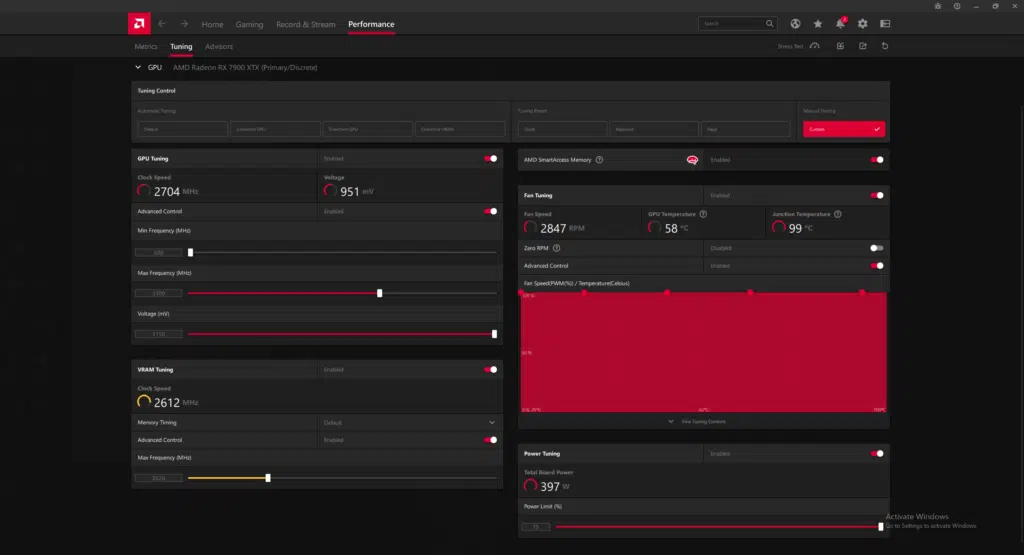
Overclocking Radeon RX 7900 XTX Performance Review
The AMD Radeon RX 7900 series GPUs are fast, but they can be faster. In this Radeon RX 7900 XTX overclocking review we are going to overclock the new AMD Radeon RX 7900 XTX video card, push the reference made by AMD video card as hard as possible, and see what kind of performance uplift we can get.
With this review of the AMD Radeon RX 7900 XTX overclocked we are going to also put it up against the competition’s GeForce RTX 4090 and GeForce RTX 4080 to see how the overclocked performance compares, as well as the Radeon RX 6900 XT. We will test at 4K, with all the graphics settings turned up, and AMD FidelityFX Super Resolution (FSR) will also be tested, as well as Ray Tracing.
The AMD Radeon RX 7900 XTX was launched on December 12th, 2022, and currently sits as the flagship, top-end SKU of AMD’s new Radeon RX 7900 series GPUs. The Radeon RX 7900 XTX is based on AMD’s new RDNA 3 architecture and a chiplet design, ushering in a new wave of GPU chip packaging pushing technology forward.
The Radeon RX 7900 XTX has 96 CUs, 6,144 Stream Processors, 192 AI Accelerators, 96 Ray Accelerators, 192 ROPs, and 96MB of AMD Infinity Cache. The Game GPU Clock is 2300MHz and the Boost GPU Clock is 2500MHz. It has 24GB of GDDR6 providing 960GB/s of memory bandwidth. The Board Power is 355W, and it has a $999 MSRP.
Read our full review for specifications and performance evaluation. We are going to use the same test setup we used in our Radeon RX 7900 XTX review. Note that AMD Smart Access Memory is enabled in all of our tests.
How to Overclock the AMD Radeon RX 7900 XTX
The first thing to do is to launch the AMD Radeon Software and navigate to Performance, and then Tuning, and select Custom to enable Manual Tuning in the software. From here we can enable all the advanced options, and set ourselves up for the win. We can increase the Power Tuning on this video card by +15%, and we can enable 100% fan speeds to ensure the highest stable overclock. We are also able to dial in the Max Frequency slider, and Memory Frequency slider with plenty of headroom on the sliders, they do not hold us back for potential. We cannot, however, raise the Voltage, the default Voltage was at 1150mV.
So keep these numbers in mind in regards to overclocking the Radeon RX 7900 XTX, it has two separate clock domains, a “Front End” frequency clock, and a “Shader” frequency clock. The Shader Clock should be around 2300MHz at default, and the Front End Clock should be around 2500MHz. Because the GPU changes frequency dynamically and can boost both above the rated speeds, the actual frequency will be dynamic and vary as you play games. We get our results here by playing real games, in this case, the frequencies shown below are in Cyberpunk 2077 manually playing the game. On our graphs below we are going to show two graphs for overclocking, a Front End Frequency graph and a Shader Frequency graph so that we can show both clock speeds at default and overclocking on both graphs. We are using HWiNFO64 to log the clock speeds.

Above you can see our highest stable settings on this video card. We managed to push the Max Frequency slider up to 3300MHz, now this is not what you will actually get in-game, it is rather a maximum allowance for the GPU to boost higher. You are basically raising the bar at which the GPU can boost, but do not think that you are going to see the exact frequency the slider shows. The only way to know the real frequency is to run a game, and see what HWiNFO64 tells you the Shader Clock and Front End Clock are while gaming.
We also managed to overclock the memory up to 21GHz from the default 20GHz. Now, this comes with a major note here. We were actually able to overclock the memory much higher, up to 22GHz at least. However, we noticed that the more we raised the memory overclock, the lower the GPU frequencies were when we played games, even with the Max Frequency raised. The reason for this is simple, the video card was hitting the board power limits, and thus power throttling down the GPU frequencies when the memory frequencies were raised too high. So while we could get the memory to overclock higher, it overall resulted in a detriment to the GPU frequency overclock.
Therefore we opted to keep the memory overclock lower, and find a better balance so that the GPU frequencies would remain higher. We found that the GPU frequencies being higher resulted in a greater performance uplift, rather than the memory being higher. The video card did not seem to be memory starved, but rather engine-starved. Therefore prioritizing the GPU clock frequency was preferred. With the memory at 21GHz, the memory bandwidth has increased to 1008GB/s versus the 960GB/s at 20GHz.
